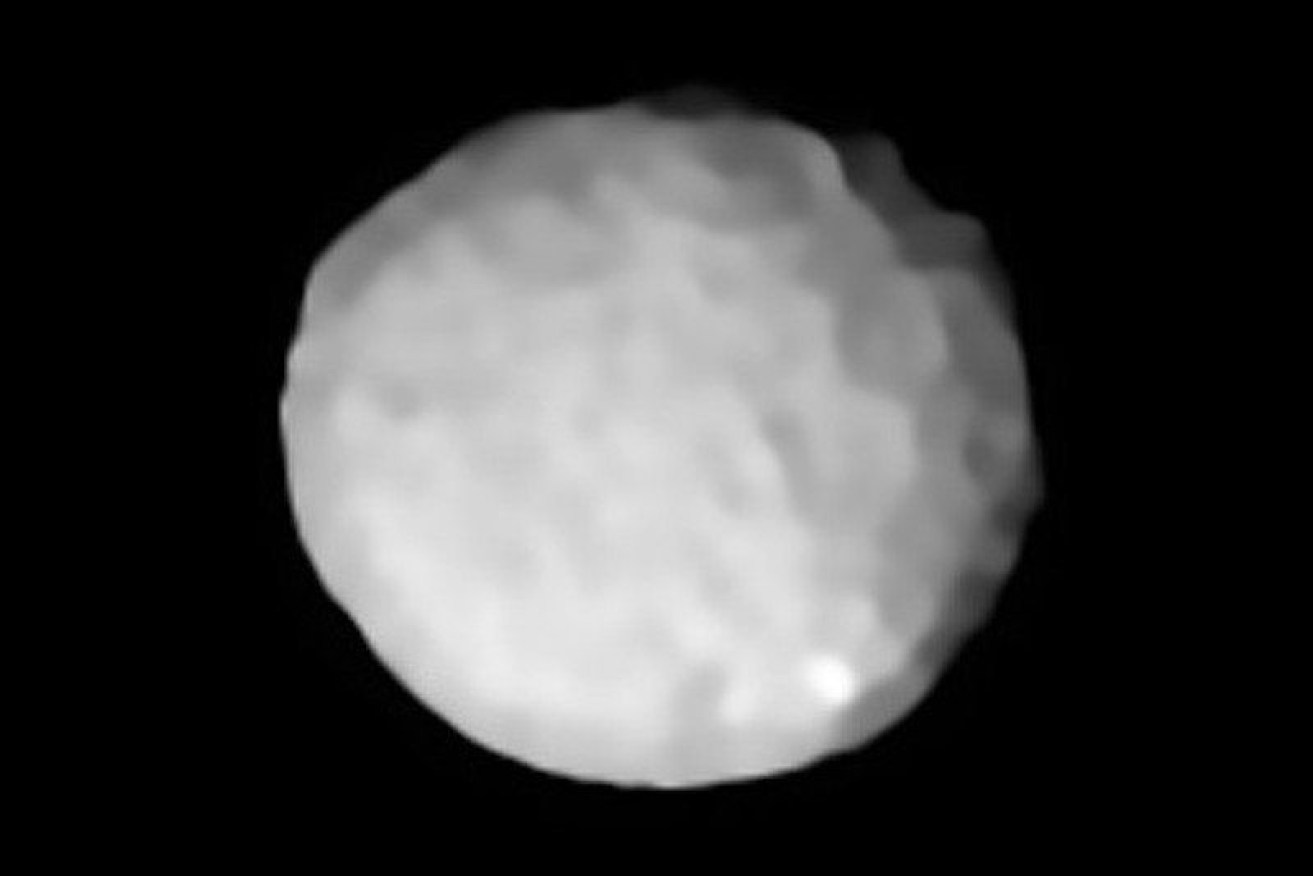Giant asteroid gets badly beaten up for going its own way


Pallas was named after the Goddess of wisdom, but doesn't seem smart at all. Image: ESO / M. Marsset el al.
The asteroid Pallas has been renamed “the golf ball asteroid” by MIT researchers after new images reveal it is probably the most beaten-up object in the Solar System.
Named after the Greek goddess of wisdom, Pallas behaves with the least good sense of any rock.
Its crazy line of travel suggests it’s mysteriously drunk – or one of those hapless personalities that tries to dodge everybody on the footpath, only to bump into them anyway.
As the researchers explain in a prepared statement: “While most objects in the asteroid belt travel roughly along the same elliptical track around the sun, much like cars on a race course, Pallas’s tilted orbit is such that the asteroid has to smash its way through the asteroid belt at an angle.
“Any collisions that Pallas experiences along its way would be around four times more damaging than collisions between two asteroids in the same orbit.”
Thankfully, Pallas is big – in fact the third-largest object in the asteroid belt, which is more or less located between the orbits of Jupiter and Mars.
“Pallas’ orbit implies very high-velocity impacts,” said Dr Michael Marsset, lead author of the paper and a postdoctoral associate in MIT’s Department of Earth, Atmospheric and Planetary Sciences.
“From these images, we can now say that Pallas is the most cratered object that we know of in the asteroid belt. It’s like discovering a new world.”
(In the department’s online directory, Dr Marsset is described as an astronomer trying to decipher the history of our Solar System through the study of small celestial bodies.)

Images of Pallas from 2017, left, and 2019, showing two sides of the asteroid, both of them dotted with craters. Image: ESO/M. Marsset et al.
Pallas, in 1802, was the second asteroid ever to be discovered.
It stuck out, given that it comprises an estimated seven per cent of the entire mass in the asteroid belt.
Pallas has an average diameter of about 513 kilometres) – about 15 per cent of the diameter of the Moon.
The researchers obtained images of Pallas using the SPHERE instrument at the European Southern Observatory’s Very Large Telescope (VLT), an array of four telescopes, each with an eight-metre-wide mirror, situated in the mountains of Chile.
In 2017, and then again in 2019, Dr Marsset and his colleagues spent several days at a time trying to capture images of Pallas at a point in its orbit that was closest to Earth.
From 11 series of images that caught Pallas from different angles as it rotated, the researchers generated a 3D reconstruction of the shape of the asteroid, along with a crater map.
They identified 36 craters larger than 30 kilometres in diameter – “about one-fifth the diameter of Earth’s Chicxulub crater, the original impact of which likely killed off the dinosaurs 65 million years ago.”
Most of the craters were at least 40 kilometres wide.

Illustration of the dinosaur-killing Chicxulub crater, shortly after its formation 66 million years ago, off the coast of present-day Mexico. The crater measures some 150 kilometres in diameter. Since its formation it has been buried in silt and covered by the sea, and is now only detectable using gravity measurements of the immediate area. Illustration: Getty
To see how violent that history likely has been, the team ran a series of simulations of Pallas and its interactions with the rest of the asteroid belt over the past four billion years, about the age of the Solar System.
They did the same with Ceres (the largest object in the asteroid belt, and reclassified as a dwarf planet in 2006) and Vesta (the second-largest object in the belt) – taking into account each asteroid’s size, mass, and orbital properties, as well as the speed and size distributions of objects within the asteroid belt.
They recorded each time a simulated collision produced a crater, on either Pallas, Ceres, or Vesta, that was at least 40 kilometres wide (the size of most of the craters that they observed on Pallas).
They found that a 40-kilometre crater on Pallas “could be made by a collision with a much smaller object compared to the same size crater on either Ceres or Vesta”.
They concluded that “Pallas experiences two to three times more collisions than Ceres or Vesta, and its tilted orbit is a straightforward explanation for the very weird surface that we don’t see on either of the other two asteroids.”








